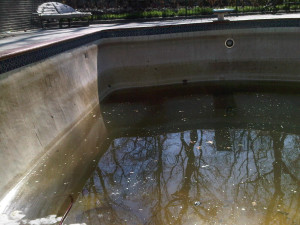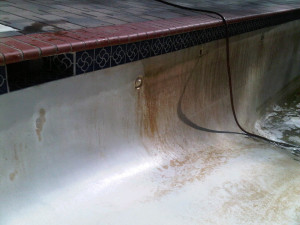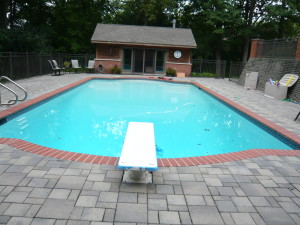An acid wash is when muratic acid is applied to a plaster, pebble or aggregate finish of a gunite swimming pool to dissolve and remove material build up and staining from a pool surface.
Acid washing removes surface stains and restores a finish to “looking like new.”
Acid washes achieve the restorative effect by breaking down the top layer of the plaster, marcite, pebble or aggregate. The result is a porous and etched surface (visible through magnification). Acid washes can restore a pool to looking like new. The more a pool is acid washed, the more the surface breaks down, and becomes more subject to staining or blotching in the future. It’s important for this reason to only acid wash when warranted, and know that eventually a renovation of the actual surface may be in order.
*an important note for homeowners: if you attempt to acid wash your surface yourself, please take precautions when draining your pool. Understand your water table, make sure your hydrostatic valve will work properly if the ground water pressure is greater than your pool pressing down into the ground – you don’t want to take the chance of a pool pop out. The best time to perform an acid wash is when the ground is dry (not during rainy mosoon season).
How do you know when it is time for an acid wash? When your pool looks like this may be an indication:
 The pool will be drained, and acid washing will begin immediately.
The pool will be drained, and acid washing will begin immediately.
 As the pool drains all the way to the bottom the acid wash is almost complete. It is important that once the acid washing is complete the garden hose or a water truck begins to put water back in the pool right away.
As the pool drains all the way to the bottom the acid wash is almost complete. It is important that once the acid washing is complete the garden hose or a water truck begins to put water back in the pool right away.
 The pool is filled back up and normal operation can commence. It is important to test your water and balance it after the acid wash to return the levels to the normal water chemistry, especially your calcium levels in a gunite pool, as well as alkalinity, pH and stabilizer.
The pool is filled back up and normal operation can commence. It is important to test your water and balance it after the acid wash to return the levels to the normal water chemistry, especially your calcium levels in a gunite pool, as well as alkalinity, pH and stabilizer.

